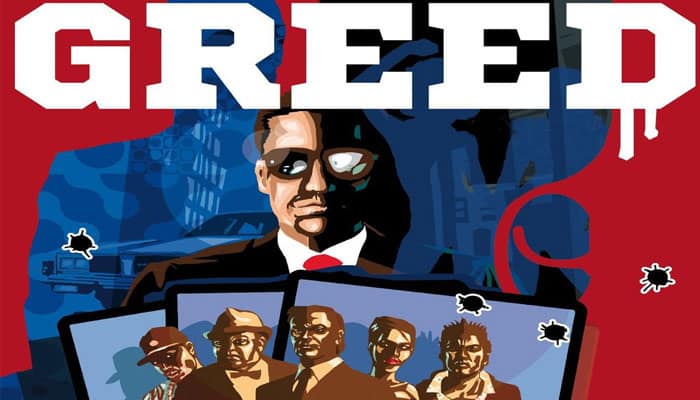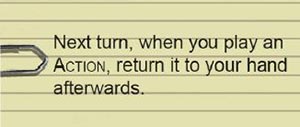

Components
- 30 action cards
- 25 thug cards
- 25 holding cards
- Money
- 54 development markers
- Instructions
Cards

Object of the Game
Make sure that you get your share of the city's wealth by any means legal or otherwise.
The player with the most money at the end of the game wins!
Setup
Mix all cards thoroughly. Give a pile of 12 cards to each player, which they keep face down to their right. The remaining cards form the draw pile in the center of the playing area.
Place the money by denomination and put it in easy reach of all players next to the draw pile, together with the development markers. Players start the game without any money or development markers.

Game Play
The game is played over 12 game rounds. During the first 2 game rounds players can only perform the 1st Phase. During the next 10 rounds players perform all the following phases in this order:
- Select one card from their own pile and add it to their hand
- Play one hand card
- Perform actions
- Resolving "each turn" abilities
The phases in detail:
Phase 1: Select one Card

Simultaneously, all players take the card pile to their right and select one card from that pile, adding it to their hand. Then, they pile the remaining cards face down to their left, between themselves and their left neighbor.
Phase 2: Play One Hand Card
Each player decides which one of his hand cards he wants to play. The players place this card face down in front of them. After all players have played a card, the cards are turned over simultaneously.
Phase 3: Perform Actions
The players compare the numbers of their played cards. The player with the lowest number begins and checks which of the following preconditions apply:
-
The played card shows some costs:
The player removes the required cards from his display or pays the demanded money. If a player does not want to bear the expenses or cannot do so, the played card is discarded without any consequences.
-
The played card shows some needs:
If the card shows some needs, the player checks if they meet these needs. The player must have the required icons on display in order to meet the needs. These cards remain in play and the icons may be used again during the next game rounds.
Even if just one single need is not met, the played card is discarded without any consequences.
-
The played card shows no costs or needs:
The player can add the card directly to his display.
This game round's player order is: Nikki - Thug (21), Keith - Holding (25), and finally Lincoln - Action (43)
Example: Nikki plays the thug (21). She can remove a thug or a holding from her display or pay $10,000. She pays $10,000 (back onto the money piles in the center) and thus has paid the costs.
Example: Lincoln plays the action card (43). The needs of this card are: 1x
and 1x
. His display includes cards with these icons, thus he has met the needs.
In case the player has paid the costs, met the needs or played it directly, he may perform the card's instructions.
Please note: The card he just played and its icons are considered part of his display.
-
Abilities in colored boxes can be used multiple times during the game, only at the times indicated.

-
"Next turn" abilities cause something to happen during the next turn, at the time or times indicated.

-
All other abilities can be used only once, either immediately or at a certain point of time (depending on the card's text).

Next, the player who played the second lowest numbered card performs his turn, etc.
Phase 4: Resolving "each Turn" Abilities
Subsequently, each player must use all "Each turn" abilities of cards in their display, in any order. Each such ability may only be used once each turn. Other abilities may trigger off of anything that happens during a game, and happen once per time the condition they look for happens.

Summary of Card Types
Action Cards
Action cards are discarded after they resolve. When an Action card does something next turn, leave it out until the end of that turn, and discard it then.
Example: Keith plays the action card (56). Nikki's holding has the most development markers (4) on it. Keith puts 4 development markers on one of his holdings as well. The action card is discarded afterwards.
Thugs
Thugs allow the players to gain money, perform additional actions or take development markers. Thug cards are added to the player's display. Their icons can be used during the remaining game rounds.
Example: Nikki plays the thug card (25), gaining $10,000for each
.
She has 2x
in her display and thus takes $20,000 from the money piles in the center.
Holdings
The players may take shares of "legal" business establishments. When doing so they place development markers on these cards. Each marker is worth $10,000 at the end of the game.
Each time a holding card is played, development markers are placed on it immediately: One marker for each icon ( ), printed on the card; furthermore one marker for each of these icons on other cards of that player's display, each time they appear.
), printed on the card; furthermore one marker for each of these icons on other cards of that player's display, each time they appear.
Example:: Lincoln plays the holding card (8) and puts 4 development markers on it:
- 2 markers for the two icons on the card itself
- 1 marker each for these two icons on other cards of his display
End of the Game
The game ends after 12 game rounds.
Note: Because no cards are played during the first two game rounds, each player usually plays only ten cards during the course of the game and still keeps two cards in his hand at the end of the game.
Each development marker is worth $10,000 at the end of the game.
Each player adds his cash to his development markers' worth and the player with the most money is the winner.
In case of a tie players share the victory.
Continue Reading






